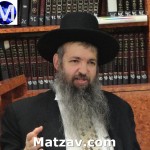We all know that the Sukkah covering, called schach, commemorates the “Ananei HaKavod,” the Clouds of Glory that sheltered and protected our ancestors during the forty miraculous years that we spent wandering in the desert after the Exodus from Egypt. This stupendous miracle was in the merit of Aharon HaKohein. The reason why it was specifically Aharon who generated for the Bnei Yisroel this amazing protection lies in the fact that Aharon was the great man of peace. As the Mishna teaches us in Pirkei Avos, “We should be from the disciples of Aharon, to love peace and pursue peace.” And because of this, it was through him that we merited the Sukkas Shelomecha, the Booths of Peace.
The Chofetz Chaim teaches us that we should be especially careful not to get angry in the environs of the Sukkah. This is not simply because it would be grossly inappropriate to lose our temper in the presence of the Holy Ushpizin, nor is it simply because it would be an act of brazen chutzpah to fly-off the handle under the schach which symbolizes the Tzeila Deimenusa, the Zohar’s terminology for the presence of the Shechinah. It is also because getting angry in the Sukkah is the antithesis of the message of the schach which is a message of peace, harmony, and tranquility.
When Hashem was about to create Man, He exclaimed, “Naase Adom, – Let us make Man.” Rashi explains that He was conferring with the angels, teaching us that it should not be above us to take counsel from our inferiors. However, the father of Chassidus, the great Baal Shem Tov, Zt”l, Zy”a, gives a novel explanation to Hashem’s statement of “Naase Adom.” He explains that Hashem was talking to Man himself, saying to him, “Let us together make Man,” for Hashem gave us, the human, an animal-like body that has many physical and materialistic cravings. In this shell he infused a holy neshamah. He then gave us the great charge to make out of that human animal an Adom, a mentch. As we say in our kiddush, “Asher borah Elokim laasos,” that Hashem created and it is our job to develop the creation further. The Gemora also elaborates on this expectation when it teaches us that if we live properly, it is “Kiilu naase shutaf l’haKodosh Boruch Hu b’maasei bereishis – We become a partner with Hashem in the very creation.”
By doing mitzvahs, we make a holy Adom out of the humanoid. The Netziv, Zt”l, Zy”a, elaborates that the rarified term ‘Adom’ is closely related to the term adameh, which means ‘to be like,’ and thus Adom points to the charge of man to be “adameh l’Elyon,” like the One Above. Thus, our charge in life is to rise above the needs of self-gratification and sensual pleasures and to become like Hashem.
One of the great character traits that we know about Hashem is that He is “Oseh Shalom Bimromav – He makes peace in the Heavens.” Hashem is described as the Great Peacemaker. It therefore behooves us throughout our stay on earth to pursue peace in every area in our lives, whether at home with our spouse and children, with our in-laws, at work with our co-workers, in shul, with our colleagues, and on the block with our neighbors. Let’s take the message of the Sukkah and the message of Aharon HaKoheim and rise above the pettiness of life, to become the Likeness of our Creator, and go the extra mile to find peaceful solutions. Let’s learn how to look away more often, let’s sharpen our skills at compromise and, as we grow older, let’s become mellower with age. Let’s try to adopt a posture of tolerance and not demand perfection from others but wisely be accepting of others even with their obvious faults and eccentricities. Not only is this the recipe to become beloved by our fellow men, it assures us that Hashem will treat us likewise, with tolerance and with forbearance , and look away from our occasional misdeeds and follies.
It is no wonder that Succos is known as Zman Simchaseinu, the Time of Happiness, for when there is peace there is happiness. It is no wonder that while we never invite the Holy Ushpizin into our homes, we invite them every time into our Sukkah for, when we create a rarified chamber of peacefulness and tranquility, our great ancestors feel comfortable to enter. It is similarly no wonder that the Shechinah abounds in the Sukkah for, as the Gemora teaches us in the case of a husband and wife, if there is peace between them there is the Divine Presence is in the midst. So too, the Sukkah, which is an airlock of harmony is a fitting domicile for the divine presence.
May it be the will of Hashem that our Sukkah brings home the important and challenging message of peace to all of our family members, teaching siblings not to fight with one another, reminding husbands and wives how very vital it is for them to strive to work out their differences, and urging all of us to bury the hatchet with those that we haven’t been getting along with and, in that zechus, may Hashem bless us all with a very healthy happy, and wonderful new Year.
Sheldon Zeitlin takes dictation of, and edits, Rabbi Weiss’s articles.
Rabbi Weiss is currently stepping up his speaking engagements. To bring him to your community, call now 718.916.3100 or email [email protected].
To receive a weekly cassette tape or CD directly from Rabbi Weiss, please send a check to Rabbi Moshe Meir Weiss, P.O. Box 140726, Staten Island, NY 10314 or contact him at [email protected].
Now back in print is a large size paperback edition of Power Bentching. To order call him at 718-916-3100 or email at above.
Attend Rabbi Weiss’s weekly shiur at the Landau Shul, Avenue L and East 9th in Flatbush, Tuesday nights at 9:30 p.m.
Rabbi Weiss’s Daf Yomi and Mishnah Yomis shiurim can be heard LIVE on Kol Haloshon at (718) 906-6400. Write to [email protected] for details. They can now also be seen on TorahAnyTime.com.
{Matzav.com Nerwscenter}












